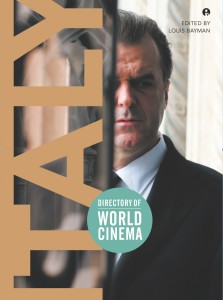Edited by Louis Bayman (Intellect, 2011). 280 pages. ISBN 978-1841504001 (paperback), £15.95; ISBN 978-1841505350 (ebook), £6.
 About the Author: Sarah Forgacs is a Doctoral candidate in Film Studies at King’s College London. Her thesis is entitled 'Filming in the feminine: Varda, Denis, Breillat & Ozon'; her wider research interests include French cinema of the New Wave and contemporary periods, feminist film theory, intersections between film and philosophy and the recent work of Laura U. Marks on film and haptics. Recent publications include Several entries in Directory of World Cinema: France (Tim Palmer & Charlie Michael eds: Intellect Press, forthcoming 2012)
Email: sarah.forgacs@kcl.ac.uk
About the Author: Sarah Forgacs is a Doctoral candidate in Film Studies at King’s College London. Her thesis is entitled 'Filming in the feminine: Varda, Denis, Breillat & Ozon'; her wider research interests include French cinema of the New Wave and contemporary periods, feminist film theory, intersections between film and philosophy and the recent work of Laura U. Marks on film and haptics. Recent publications include Several entries in Directory of World Cinema: France (Tim Palmer & Charlie Michael eds: Intellect Press, forthcoming 2012)
Email: sarah.forgacs@kcl.ac.uk
 Any attempt to compile a directory of Italian cinema within some 280 pages is a huge and unenviable feat. While scholars such as Mary Wood, Peter Bondanella and Millicent Marcus have attempted to chart the history of Italian cinema, most histories view the emergence of the Neo-Realism period and the release of Roberto Rossellini’s Roma Citta Aperta/ Rome, Open City in 1945 as the starting point and focus on works by the well-known auteurs such as Rossellini, Visconti, Antonioni and the like. This Directory is the latest in the Intellect Directory Of World Cinema series and seeks to broaden the conception of Italian cinema beyond neo realism, melodrama and horror.
Any attempt to compile a directory of Italian cinema within some 280 pages is a huge and unenviable feat. While scholars such as Mary Wood, Peter Bondanella and Millicent Marcus have attempted to chart the history of Italian cinema, most histories view the emergence of the Neo-Realism period and the release of Roberto Rossellini’s Roma Citta Aperta/ Rome, Open City in 1945 as the starting point and focus on works by the well-known auteurs such as Rossellini, Visconti, Antonioni and the like. This Directory is the latest in the Intellect Directory Of World Cinema series and seeks to broaden the conception of Italian cinema beyond neo realism, melodrama and horror.
In his Introduction, Louis Bayman poses three important questions;
- Is the more accurate image of Italian cinema one of political commitment and modernist masterworks, or the traditions of comedy and melodrama?
- Can Italian cinema principally be characterized as a socially-engaged cinema of documentary realism, or by the operatics of excessive theatricality?”
- Is its true heritage the prestige cinema of directorial genius or the popular cinema of genres and filoni (strands), the ‘cycles’ of formulaic, highly popular, low-budget productions whose brief life-spans of intense exploitation each led to total eclipse as fashions changed?
With following sections that return to the Silent Cinema of 1900s and conclude with a section on contemporary cinema, this Directory attempts to challenge the tendency of existing scholarship to focus on the heyday of Italian cinema’s post-war period. Bringing together contributions from some of the leading scholars on Italian cinema (namely Richard Dyer, Danielle Hipkins and Catherine O’ Rawe), alongside newer scholars who have either recently completed theses on Italian cinema (Alex Marlow-Mann and Sergio Rigoletto) or who maintain an interest in Italian cinema.
http://youtu.be/UUXEAhJb_O0
Following the Introduction is a couplet of essays on two ‘Films of the Year:’ Luca Guadagino’s 2009 film Io Sono l’amore/ I Am Love and Michelangelo Frammartino’s 2010 Le Quattro Volte/ The Four Times. This leaves the reader wondering ‘films of the year’ according to whom? and on what grounds where these films selected as ‘films of the year?’ The first film was made in 2009, the second in 2010, so which ‘year’ are we in fact talking about? After this couplet of essays and before we get to the main body of the book, there is an interview with Valerio Jalongo, a founding member of the ‘Centoautori’ film movement and the director of Di me cosa ne sai/What Do You Know About Me? before another essay from the editor about the cultural crossover between opera and cinema and finally two case studies of the directors Federico Fellini and Nanni Moretti. These short pieces would perhaps be better as appendices towards the end of the book, as we don’t actually get to the Directory itself until page 33.
The Directory itself is divided into sections which deal with the various genres of Italian Cinema, featuring roughly twelve essays per section preceded by a framing essay, beginning with Silent Cinema which opens with the assertion that 1905 is a ‘foundational date in the history of Italian cinema,’ before proceeding with sections on the more well-known aspects of Italian cinema, such as Neorealism, Giallo and Political Cinema and the often over-looked genres such as Peplum (the ‘sword and sandal’ film), Spaghetti Western and Comedy.
As a guide for students seeking to broaden their knowledge of Italian cinema, this Directory seems like a good place to start
Unfortunately the Directory lacks a concluding essay, which brings all the separate sections together, instead choosing to include a list of relevant books and websites and a rather redundant ‘Test Your knowledge’ quiz which it is hard to imagine students actually taking. In its aims to provide a comprehensive Directory of Italian cinema which seeks to broaden one’s conception of this national cinema beyond auteurism and the well-known genres of horror, melodrama and neo-realism, this book succeeds in its aim. As a guide for students seeking to broaden their knowledge of Italian cinema, this Directory seems like a good place to start.
Sarah Forgacs